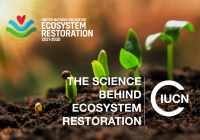Ecosystem Management
The well-being of people all over the world depends on healthy ecosystems to provide goods, like food and water, and services like climate regulation and protection from natural hazards.
News
-
 Sustainably managed mangroves can provide ecosystem services such as coastal protection, food and medicines as well as carbon storage, positively impacting both biodiversity and human well-being. The IUCN Global Standard for NbS provides a tool to help ensure that projects labelled as Nature-based Solutions - for example through restoration of mangroves - do indeed deliver the anticipated benefits to both society and biodiversity.
Photo: Maxwell Ridgway / Unsplash
Sustainably managed mangroves can provide ecosystem services such as coastal protection, food and medicines as well as carbon storage, positively impacting both biodiversity and human well-being. The IUCN Global Standard for NbS provides a tool to help ensure that projects labelled as Nature-based Solutions - for example through restoration of mangroves - do indeed deliver the anticipated benefits to both society and biodiversity.
Photo: Maxwell Ridgway / Unsplash
Follow IUCN Ecosystems
Learn more
Global Drylands Initiative
Drylands are found in tropical and temperate latitudes and account for 41.3% of the global terrestrial area. They can be classified into four types - dry sub-humid, semi-arid, arid and hyper-arid lands - encompassing a variety of ecosystems.
The goal of the Global Drylands Initiative...
Global Island Partnership
Work together to build resilient and sustainable island communities by inspiring leadership, catalyzing commitments and facilitating collaboration for all islands.
Environment and Disasters
Climate change is increasing the frequency and intensity of climate-related hazards Nature-based solutions can help communities prepare for, cope with, and recover from disasters.
Ecosystem-based Approaches to Climate Change Adaptation
Ecosystem-based Approaches to Climate Change Adaptation, or Ecosystem-based Adaptation (EbA) involves a wide range of ecosystem management activities to increase the resilience and reduce the vulnerability of people and the environment to climate change.
Quick reads
Aimed at policy-makers and journalists, IUCN Issues Briefs provide key information on selected issues in a two-pager format.















